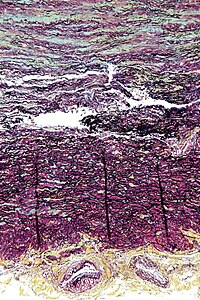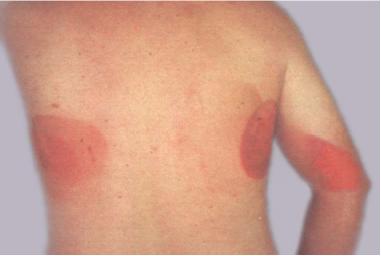- Formicophilia Wikipedia
- Smut (Fungus) Wikipedia
- Pineal Gland Cyst Wikipedia
-
Vaccine-Preventable Diseases
Wikipedia
For example, residents of Canada and the United States do not routinely receive vaccines against yellow fever , which leaves them vulnerable to infection if travelling to areas where risk of yellow fever is highest (endemic or transitional regions). [4] [5] List of vaccine-preventable diseases [ edit ] A child being immunized against polio The WHO lists 28 diseases (excluding COVID-19 ) for which vaccines are available: [2] Cholera COVID-19 (available but not on current WHO list) Dengue fever [6] Diphtheria Ebolavirus Haemophilus influenzae type b Hepatitis A Hepatitis B Hepatitis E Human papillomavirus infection Influenza Japanese encephalitis Malaria [6] Measles Meningococcal disease Mumps Pneumococcal disease Pertussis Poliomyelitis Rabies Rotavirus gastroenteritis Rubella Tetanus Tick-borne encephalitis Tuberculosis Typhoid fever Varicella Yellow fever Shingles (Herpes Zoster) Used in non humans [ edit ] Bordetella Canine distemper Canine influenza Canine parvovirus Chlamydia Feline calicivirus Feline distemper Feline leukemia Feline viral rhinotracheitis Leptospirosis Lyme disease Vaccine-preventable diseases demonstrated in the laboratory on other animals [ edit ] This section needs expansion .
-
Upper Motor Neuron Lesion
Wikipedia
. ^ "The Precise Neurological Exam" . Retrieved 2009-11-28 . External links [ edit ] Classification D DiseasesDB : 27852 v t e Symptoms and signs relating to movement and gait Gait Gait abnormality CNS Scissor gait Cerebellar ataxia Festinating gait Marche à petit pas Propulsive gait Stomping gait Spastic gait Magnetic gait Truncal ataxia Muscular Myopathic gait Trendelenburg gait Pigeon gait Steppage gait Antalgic gait Coordination Ataxia Cerebellar ataxia Dysmetria Dysdiadochokinesia Pronator drift Dyssynergia Sensory ataxia Asterixis Abnormal movement Athetosis Tremor Fasciculation Fibrillation Posturing Abnormal posturing Opisthotonus Spasm Trismus Cramp Tetany Myokymia Joint locking Paralysis Flaccid paralysis Spastic paraplegia Spastic diplegia Spastic paraplegia Syndromes Monoplegia Diplegia / Paraplegia Hemiplegia Triplegia Tetraplegia / Quadruplegia General causes Upper motor neuron lesion Lower motor neuron lesion Weakness Hemiparesis Other Rachitic rosary Hyperreflexia Clasp-knife response
-
Dialysis Disequilibrium Syndrome
Wikipedia
"A preliminary report of brain edema in patients with uremia at first hemodialysis: evaluation by diffusion-weighted MR imaging". AJNR Am J Neuroradiol . 28 (1): 68–71. PMID 17213426 . External links [ edit ] Dialysis disequilibrium syndrome at the United States National Library of Medicine Dialysis Disequilibrium Syndrome (DDS) – Rare but serious complication of dialysis
-
Pleomorphic Anaplastic Neuroblastoma
Wikipedia
Pleomorphic anaplastic neuroblastoma (PAN) is a striking aspect of neuroblastoma first described by Cozzutto and Carbone in 1988. [1] Another case was thereafter reported by Cowan, et al. with cytogenetic and immunohistological analysis in a 28-year-old man. [2] The case described by Navarro, et al. showed MYCN amplification (more than 10 copies) and a 1p36 deletion as measured with FISH in 13% of cells. [3] Additionally there was a main cell population with a DNA index of 2 indicating a tetraploid DNA content and a high expression of MIBI (Ki-67), bel 2, p53, and P-glycoprotein , either correlated with rapid progression of disease.
- Pontocerebellar Hypoplasia, Type 1c Omim
-
Ophthalmoplegia, External, With Rib And Vertebral Anomalies
Omim
Analysis of the MYF5 gene in probands from 28 recessive, 26 dominant, and 51 simplex pedigrees with congenital ophthalmoplegia did not reveal any rare homozygous or compound heterozygous variants.
-
Neurodevelopmental Disorder With Impaired Intellectual Development, Hypotonia, And Ataxia
Omim
Iwata-Otsubo et al. (2018) reported a 28-month-old boy, born of consanguineous parents, with global developmental delay, hypotonia, and speech/language delay with only a few words.
- Subungual Exostosis Wikipedia
-
Musicogenic Epilepsy
Wikipedia
Of the approximately 100 patients reported in the literature so far, about 75% had temporal lobe epilepsy, women were slightly more affected, and the mean age of onset was about 28 years. [12] Ictal EEG and SPECT findings [13] [14] as well as functional MRI studies [15] localized the epileptogenic area predominantly in the right temporal lobe.
-
Spondyloepimetaphyseal Dysplasia, Aggrecan Type
Omim
INHERITANCE - Autosomal recessive GROWTH Height - Short stature, disproportionate (adult height 26-28 inches) Other - Upper/lower segment ratio 1.1-1.2 HEAD & NECK Head - Macrocephaly, relative Face - Prognathism, relative - Midface hypoplasia Ears - Low-set posteriorly rotated ears Nose - Absent nasal bridge Neck - Short neck RESPIRATORY Airways - Bronchospasm (in 1 patient) CHEST External Features - Barrel-shaped chest SKELETAL - Spondyloepimetaphyseal dysplasia (SEMD) - Joint laxity (especially hands) Spine - Platyspondyly - Multiple cervical-vertebral clefts - Lumbar lordosis, mild Limbs - Irregular epiphyses - Widened metaphyses - Mesomelia - Rhizomelia Hands - Brachydactyly - Short, broad thumbs - Telescoping interphalangeal joints - Accessory carpal ossification centers SKIN, NAILS, & HAIR Nails - Horizontal nail beds VOICE - Hoarse voice MISCELLANEOUS - One family from Zacatecas, Mexico has been described (last curated August 2017) MOLECULAR BASIS - Caused by mutation in the aggrecan gene (ACAN, 155760.0002 ) ▲ Close
-
Fetal Distress
Wikipedia
Clinical Obstetrics and Gynecology . 54 (1): 28–39. doi : 10.1097/GRF.0b013e31820a062b .OXT, EPOR, EPO, NDUFAF1, ATP8B1, ABCB4, RPL11, SLC6A9, SON, NDUFAF3, OSTM1, NDUFAF4, ALDH7A1, NDUFB11, FOXRED1, TMEM126B, ALG8, NDUFAF5, NUBPL, NDUFAF2, NDUFA11, TIMMDC1, NDUFV2, NDUFS8, NDUFB9, IL1RN, ND1, ND2, ND3, NDUFA1, NDUFA6, NDUFS6, NDUFB3, NDUFB10, NDUFS1, NDUFS2, NDUFS3, NDUFV1, NDUFS4, NDUFS7, PTPRC, KCNQ1, IL6, HSD11B2
-
Williams Syndrome
Medlineplus
Causes Williams syndrome is caused by the deletion of genetic material from a specific region of chromosome 7. The deleted region includes 26 to 28 genes, and researchers believe that a loss of several of these genes probably contributes to the characteristic features of this disorder.GTF2IRD1, BAZ1B, GTF2I, LIMK1, DLG4, ELN, MLXIPL, FKBP6, CLIP2, FZD9, EIF4H, LOX, SRC, FBN1, STX1A, ADAMTS17, GTF2IRD2, ADAMTS10, NCF1, RFC2, CALCA, FZD3, NSUN5, BCL7B, LAT2, WRN, S100A12, ARSD, PDLIM1, GTF2IP1, CDKN1C, BUD23, H2AX, ATR, ZRS, DECR1, CLDN3, CLDN4, CTCF, ZNF763, DNAJC30, PDLIM5, ADAMTSL2, ZNF629, TRIM73, TRIM74, PLF, STAG3, CBLL2, PRPF31, EBPL, ZNF569, TBL2, SIRPA, PCLO, TRIM50, ZNF501, ZNF44, TRPV6, PRDM9, NSD1, MUL1, ZNF436, RCC1L, ACTB, VDR, HSPB3, ELK3, LTBP2, HTC2, HSPB2, HSPB1, GABRA1, FRA7G, FMR1, DMBT1, FZD1, DDX11, COX8A, CALCR, CACNA2D1, SERPING1, BCL7A, AVP, SMAD1, MBNL1, NCF4, PRKN, FZD5, ZNF143, ZNF24, TRPC3, TG, HNF1B, SYN1, SPRR2A, CLIP1, POMC, PMS2, PMP22, PLS3, SERPINA1, PCNA, WBSCR23
-
Familial Thoracic Aortic Aneurysm
Wikipedia
External links [ edit ] Classification D ICD - 9-CM : 441.00 OMIM : 607086 DiseasesDB : 30073 External resources eMedicine : emerg/28 GeneReview/NCBI/NIH/UW entry on Thoracic Aortic Aneurysms and Aortic Dissections v t e Cardiovascular disease (vessels) Arteries , arterioles and capillaries Inflammation Arteritis Aortitis Buerger's disease Peripheral artery disease Arteriosclerosis Atherosclerosis Foam cell Fatty streak Atheroma Intermittent claudication Critical limb ischemia Monckeberg's arteriosclerosis Arteriolosclerosis Hyaline Hyperplastic Cholesterol LDL Oxycholesterol Trans fat Stenosis Carotid artery stenosis Renal artery stenosis Other Aortoiliac occlusive disease Degos disease Erythromelalgia Fibromuscular dysplasia Raynaud's phenomenon Aneurysm / dissection / pseudoaneurysm torso : Aortic aneurysm Abdominal aortic aneurysm Thoracic aortic aneurysm Aneurysm of sinus of Valsalva Aortic dissection Aortic rupture Coronary artery aneurysm head / neck Intracranial aneurysm Intracranial berry aneurysm Carotid artery dissection Vertebral artery dissection Familial aortic dissection Vascular malformation Arteriovenous fistula Arteriovenous malformation Telangiectasia Hereditary hemorrhagic telangiectasia Vascular nevus Cherry hemangioma Halo nevus Spider angioma Veins Inflammation Phlebitis Venous thrombosis / Thrombophlebitis primarily lower limb Deep vein thrombosis abdomen Hepatic veno-occlusive disease Budd–Chiari syndrome May–Thurner syndrome Portal vein thrombosis Renal vein thrombosis upper limb / torso Mondor's disease Paget–Schroetter disease head Cerebral venous sinus thrombosis Post-thrombotic syndrome Varicose veins Gastric varices Portacaval anastomosis Caput medusae Esophageal varices Hemorrhoid Varicocele Other Chronic venous insufficiency Chronic cerebrospinal venous insufficiency Superior vena cava syndrome Inferior vena cava syndrome Venous ulcer Arteries or veins Angiopathy Macroangiopathy Microangiopathy Embolism Pulmonary embolism Cholesterol embolism Paradoxical embolism Thrombosis Vasculitis Blood pressure Hypertension Hypertensive heart disease Hypertensive emergency Hypertensive nephropathy Essential hypertension Secondary hypertension Renovascular hypertension Benign hypertension Pulmonary hypertension Systolic hypertension White coat hypertension Hypotension Orthostatic hypotension This cardiovascular system article is a stub .
-
Cholestasis, Progressive Familial Intrahepatic, 2
Omim
Using immunohistochemistry, Jansen et al. (1999) found absence of the BSEP protein in 16 of 28 liver biopsy samples from patients with PFIC.
-
Hyperinsulinemic Hypoglycemia, Familial, 4
Omim
Flanagan et al. (2013) stated that the 636+471G-T Turkish founder mutation was the most common HADH mutation in their cohort and accounted for 9 (32%) of 28 individuals with HADH mutations. INHERITANCE - Autosomal recessive NEUROLOGIC Central Nervous System - Seizures, hypoglycemic - Coma, hypoglycemic - Mental retardation due to repeated episodes of hypoglycemia ENDOCRINE FEATURES - Hyperinsulinemic hypoglycemia LABORATORY ABNORMALITIES - Hypoglycemia - Hyperinsulinemia - Elevated blood spot hydroxybutyryl carnitine MISCELLANEOUS - Genetic heterogeneity (see HHF1 256450 ) MOLECULAR BASIS - Caused by mutation in the L-3-hydroxyacyl-CoA dehydrogenase gene (HADH, 601609.0003 ) ▲ Close
- Diabetes Mellitus, Transient Neonatal, 3 Omim
-
Radiation Burn
Wikipedia
A study of radiation-induced skin injuries [27] [28] has been performed by the Food and Drug Administration (FDA) based on results from 1994, [29] followed by an advisory to minimize further fluoroscopy-induced injuries. [30] The problem of radiation injuries due to fluoroscopy has been further investigated in review articles in 2000, [31] 2001, [32] [33] 2009 [34] and 2010. [35] [36] [37] Radioactive fallout [ edit ] Beta burns are frequently the result of exposure to radioactive fallout after nuclear explosions or nuclear accidents . ... Twenty-three U.S. radar servicemen of the 28-member weather station on Rongerik [41] were affected, experiencing discrete 1–4 mm skin lesions which healed quickly, and ridging of fingernails several months later. Sixteen crew members of the aircraft carrier USS Bairoko received beta burns, and there was an increased cancer rate. [15] During the Zebra test of the Operation Sandstone in 1948, three men suffered beta burns on their hands when removing sample collection filters from drones flying through the mushroom cloud ; their estimated skin surface dose was 28 to 149 Gy, and their disfigured hands required skin grafts . ... Some firefighters suffered beta burns of lungs and nasopharyngeal region after inhalation of massive amounts of radioactive smoke . Out of 28 deaths, 16 had skin injuries listed among the causes. ... Several died of fourth degree beta burns between 9–28 days after dose of 6–16 Gy. Seven died after dose of 4–6 Gy and third degree beta burns in 4–6 weeks.








